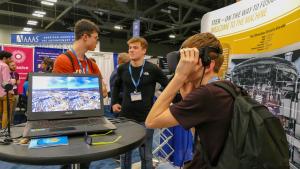Science in Texas
ITER draws enthusiasm
19 Feb 2018
-
Kirsten Haupt
At its Annual Meeting in Austin, Texas, the American Association for the Advancement of Science, AAAS, invited participants to illustrate how investment in basic research, and the translation of discovery into applications, can help improve the human condition and drive economic growth.
There was a never-ending stream of visitors at the ITER stand, including many young students like these three from the UK.
In lectures, seminars and discussions held over the five days of the AAAS meeting, scientists, engineers, students, practitioners and communicators covered a multitude of disciplines—ranging from medicine to astrophysics, from safe food to alternative energy. Communication, public engagement and international collaboration were central themes.
In one of the main plenary sessions, veteran astronaut Ellen Ochoa presented the International Space Station (ISS) as a "stunning example of international partnership and science diplomacy." Beyond the 15 participating nations—eleven from Europe plus Canada, Japan, Russia and the US—she pointed out that many more countries were benefiting from this "human outpost in space" through various initiatives, including educational partnerships.
The ISS applies a model of international collaboration and participation that is similar to ITER, including contributions delivered "in kind." Speaking about the US experience, Ochoa said that the 100 suppliers from 40 states had experienced direct economic benefits. She presented examples of supply companies securing new business opportunities as a direct consequence of their involvement with the ISS project.
ISS, CERN and ITER featured as case studies in the research presented on mega science projects by Mark Robinson of Durham University. According to Robinson, the political and societal lessons that can be gleaned from these projects can help international collaboration to address global challenges in other fields.
Saturday was dedicated to families, and the young generation took over the Austin Convention Center. Children of all ages enjoyed a special exhibition and displayed a refreshing level of curiosity for all things science.
The wave spilled over into the main exhibition hall. Many children came to the ITER stand, clearly drawn in by the virtual reality presentation of the ITER worksite.
The children's enthusiasm was shared by most visitors to the ITER stand. It was an interesting mix: diplomats and policy makers, students and educators, scientists and engineers, and even some former ITER staff.
The majority of visitors was new to the field of fusion and had many questions on science, technology and recent engineering achievements. ITER's model of international collaboration, particularly the aspects of in-kind contributions and the sharing of intellectual property, drew a lot of interest.


